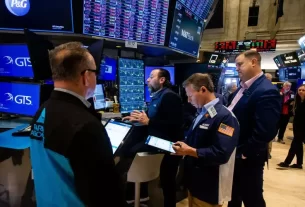What was the biggest financial fraud in U.S. history, and what can we learn from it?
Bernie Madoff’s $65 billion Ponzi scheme is the largest financial fraud in U.S. history. It highlights the importance of due diligence, skepticism of “too-good-to-be-true” returns, and regulatory oversight to prevent similar scams.

The Cost of Financial Deception
Fraudulent schemes have plagued the stock market and financial systems for decades, eroding trust and causing devastating losses for individuals and institutions alike. Among these, Bernie Madoff’s Ponzi scheme stands out as the largest financial fraud in U.S. history, defrauding investors of $65 billion. This article delves into the mechanics of such schemes, their warning signs, and actionable strategies to protect yourself from falling victim to similar crimes.
By exploring infamous cases like Madoff’s, Enron, and Theranos, we aim to provide readers with a comprehensive understanding of how these frauds operate and their broader implications on the economy.
Bernie Madoff’s $65 Billion Ponzi Scheme: A Case Study
How the Scheme Worked
Bernie Madoff, once a respected figure on Wall Street and former chairman of NASDAQ, orchestrated a massive Ponzi scheme through his asset management firm. He promised consistent, high returns to investors by fabricating profits and using funds from new investors to pay earlier ones. This illusion of success attracted individuals, institutions, and even philanthropic organizations.
Key Red Flags
- Unrealistic Returns: Madoff consistently reported returns that were too stable to be true, even during market downturns.
- Lack of Transparency: Investors were discouraged from asking questions about his strategy or accessing detailed reports.
- Exclusive Access: The scheme thrived on creating a sense of exclusivity, making investors feel privileged to participate.
Impact on Victims
The fallout was catastrophic:
- Individuals lost life savings.
- Charitable foundations collapsed, including the $1 billion Picower Foundation.
- Trust in financial institutions was severely damaged.
Other Infamous Financial Scandals
While Madoff’s scheme is the largest in scale, other notable cases highlight different forms of financial fraud:
1. Enron (2001)
Enron’s executives used accounting loopholes to hide billions in debt while inflating profits. The scandal led to:
- The bankruptcy of Enron.
- The collapse of Arthur Andersen, one of the “Big Five” accounting firms.
- Regulatory reforms like the Sarbanes-Oxley Act to improve corporate governance.
2. Theranos (2018)
Elizabeth Holmes’ biotech company promised revolutionary blood-testing technology but delivered falsified results. Investors lost billions when the truth emerged, leading to Holmes’ conviction for fraud.
3. FTX Collapse (2022)
Sam Bankman-Fried’s cryptocurrency exchange FTX misused customer funds for risky investments. The collapse wiped out billions in investor assets and highlighted the risks in unregulated markets like cryptocurrency.
Common Types of Financial Fraud
Understanding various types of fraud can help you recognize warning signs early:
| Type of Fraud | Description | Impact |
|---|---|---|
| Ponzi Schemes | Using funds from new investors to pay returns to earlier ones | Total loss of investments |
| Accounting Fraud | Manipulating financial statements to hide losses | Bankruptcy and loss of shareholder value |
| Identity Theft | Stealing personal information for financial gain | Ruined credit scores and stolen assets |
| Phishing Scams | Fake emails or websites designed to steal sensitive data | Unauthorized transactions |
| Insurance Fraud | Filing false claims for payouts | Increased premiums for all policyholders |
How Financial Frauds Impact the Economy
Frauds don’t just harm individual victims—they have far-reaching consequences for the broader economy:
- Erosion of Trust: Scandals like Enron and AIG undermine confidence in corporations and financial institutions.
- Market Volatility: Large-scale frauds can destabilize markets, as seen during the 2008 financial crisis.
- Regulatory Costs: Governments spend billions on investigations and reforms to prevent future scams.
For example, after Enron’s collapse, Congress passed the Sarbanes-Oxley Act to tighten corporate accountability. Similarly, Bernie Madoff’s arrest spurred stricter oversight by the SEC.
Lessons Learned from Past Scandals
1. Importance of Due Diligence
Many victims trusted fraudulent schemes without verifying their legitimacy. Always:
- Research investment opportunities thoroughly.
- Verify credentials through official sources like FINRA or SEC databases.
2. Be Skeptical of High Returns
If an investment promises high returns with little or no risk, it’s likely too good to be true.
3. Transparency is Key
Avoid investments where details about operations or strategies are vague or inaccessible.

Protecting Yourself Against Financial Fraud
Fraudsters are constantly evolving their tactics, but you can stay ahead by following these tips:
Practical Steps:
- Verify Identities: Always confirm who you’re dealing with using official channels.
- Monitor Accounts Regularly: Check bank statements for unauthorized transactions.
- Avoid Sharing Sensitive Information: Never disclose Social Security numbers or account details over email or phone.
Technological Safeguards:
- Use antivirus software and secure passwords.
- Enable two-factor authentication for online accounts.
Reporting Suspicious Activity:
If you suspect fraud:
- Contact your bank immediately to freeze accounts.
- Report incidents to authorities like the FBI (tips.fbi.gov) or FTC (reportfraud.ftc.gov).
The Role of Regulatory Agencies
Organizations like the SEC and FBI play a critical role in uncovering frauds and protecting investors:
- The SEC enforces securities laws to ensure transparency in public companies.
- The FBI investigates white-collar crimes like Ponzi schemes and insider trading.
Recent reforms have focused on improving whistleblower protections and increasing penalties for fraudulent activities.
Future Trends in Financial Fraud Prevention
As technology evolves, so do fraud tactics. Here’s what we can expect:
- AI-Powered Scams: Fraudsters may use AI to create more convincing phishing emails or deepfake videos.
- Blockchain Security: While cryptocurrency has been exploited (e.g., FTX), blockchain technology offers potential solutions for secure transactions.
- Stronger Regulations: Governments worldwide are likely to implement stricter rules for emerging markets like cryptocurrency.
Conclusion: Staying Vigilant is Key
The largest financial frauds in U.S. history—from Bernie Madoff’s Ponzi scheme to Enron’s accounting scandal—serve as stark reminders of how deception can devastate lives and economies. By understanding how these schemes operate and recognizing their warning signs, you can protect yourself from becoming a victim.
Remember:
- Always conduct thorough research before investing.
- Be skeptical of promises that seem too good to be true.
- Stay informed about evolving scams and regulatory changes.
With vigilance and due diligence, we can build a safer financial environment where trust is restored at every level—from individual investors to global markets.
FAQ
Q: What was Bernie Madoff’s Ponzi scheme?
A: Bernie Madoff defrauded investors out of $65 billion by promising consistent returns through fabricated profits while using new investor funds to pay earlier participants.
Q: How can I identify fraudulent investment schemes?
A: Look for red flags like unrealistic returns, lack of transparency, and pressure tactics urging quick decisions without proper documentation.
Q: What are common types of financial fraud?
A: Ponzi schemes, identity theft, phishing scams, accounting fraud, and insurance fraud are among the most prevalent types.
Q: How do I report suspected financial fraud?
A: Report suspicious activity immediately to your bank, local law enforcement agencies, or federal organizations like the SEC or FBI.
Q: What lessons can we learn from past scandals?
A: Always conduct due diligence before investing, be skeptical of high-return promises, and demand transparency from investment managers or firms.



